Carruanthus peersii
Carruanthus peersii L.Bolus
Family: Aizoaceae
Common names: Toorwaterpoort mesemb (Eng.); Toorwatervygie (Afr.)
Introduction
Carruanthus peersii is only known from the cliffs of Toorwaterpoort. It is a small, cliff-hugging, branched shrublet becoming a hanger with age, with pale greyish-green succulent leaves and yellow daisy-like flowers. It is easy to grow and makes a rewarding pot plant.

Fig. 1. Carruanthus peersii in flower growing in the succulent collection of Kirstenbosch National Botanical Garden, collected at Toorwaterpoort, 4 April 2002.
Description
Description
Carruanthus peersii is slow growing, and plants are initially solitary, but divide to form small, dense, mat-like clusters up to 300 mm in diameter, becoming pendent, with stems up to 500 mm long, with about 10–25 heads, each head with 6–8 functional green leaves withering and becoming deciduous from below. The roots are fibrous. Branches up to 5 mm in diameter, greyish brown, with remnants of old dried leaf bases; older branches up to 10 mm in diameter. Leaves spreading ascending, crowded or with short internodes up to 10 mm long, in opposite pairs (decussate) and slightly connate at the base, oblong triangular club-shaped (trigonous-clavate), linear-oblanceolate when viewed from the top, 30–60 × 15 mm, lateral compression at apex about 10 mm in diameter, somewhat dorsiventrally compressed, keeled below; surface grey-green, smooth, becoming wrinkled and purplish green during drought; the leaf tips pointed or blunt (apex obtuse to acute), somewhat laterally compressed. Flowers yellow, in dichotomous cymes, only opening in late afternoon, 25–50 mm in diameter; axillary flower often suppressed in autumn; pedicels terete, 2 mm in diameter, thickened to 4 mm (10–)20–30(–42) mm long, with 1 or 2 pairs of small leaf sheaths; bracts trigonous, 5–6 mm long, keel decurrent on pedicel. Petals numerous in 2 series, linear-lanceolate, 10–22 × 1–1.5 mm, radiate and incurved. Stamens erect, 7–9 mm long, white at base, numerous and crowded at first in a column. Ovary inferior, with raised, ridged, conical centre up to 2 mm high, glands 5, linear, 1.3 × 0.5 mm, separate, greenish yellow; stigmas 5 mm long, filiform, apices becoming coiled outward. Fruiting capsule 10 × 10 mm, opening with moisture (hygrochastic), bowl-shaped, covering membranes rudimentary (0.5 mm ledge) and almost absent. Seed ovoid, 0.5 × 0.9 mm, light brown. Flowering time is in spring (August–November) and it flowers sporadically throughout the year.

Fig. 2. A closer look at a large cluster of Carruanthus peersii on a cliff at Toorwaterppoort. Note the fruiting capsule.
Conservation Status
Status
Carruanthus peersii is rare and only known from dry cliff-faces along the lower eastern Swartberg. Due to its inaccessible habitat, which keeps it safe from most threats, it is assessed as Least Concern (LC) in SANBI’s Red List of South African Plants.
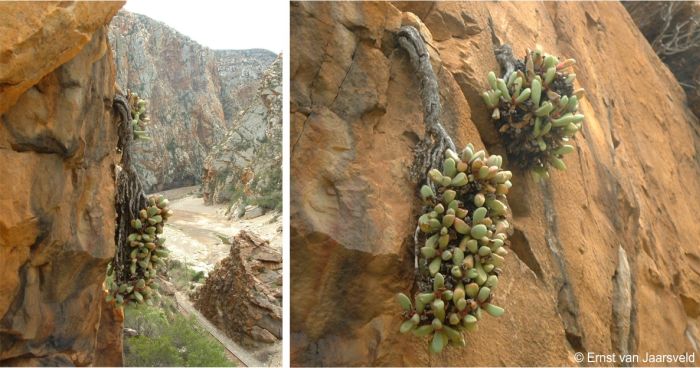
Fig. 3. Two plants of Carruanthus peersii growing in crevices on a cliff in habitat at Toorwaterpoort, Eastern Cape on 4 April 2002. The plant is slow growing and becomes a cliff hanger with age.
Distribution and habitat
Distribution description
Carruanthus peersii is only known from the lower eastern Groot Swartberg, growing in deep sheer kloofs at Toorwaterpoort, between the Slypsteenberg to the east and Groot Swartberg to the west, in the Western and Eastern Cape. Plants are confined to east- and west-facing Witteberg Quartz cliffs (Cape Supergroup), growing in crevices and on ledges of the lower and upper slopes, in ample soil, at an altitude 800–1 200 m. The climate is hot and dry, with rainfall in summer and winter. The average daily maximum temperature is about 25°C and average daily minimum about 10°C, with frost absent from the habitat. Rainfall occurs in winter and summer in the form of cyclonic cold fronts and thunder showers, 200–300 mm per annum. The vegetation consists of Gamka Thicket of the Albany Thicket Biome (Mucina et al. 2005). In its habitat, at Toorwaterpoort, other cliff-dwellling succulents observed include Adromischus subdistichus, Albuca tortuosa, Bulbine rupicola, Cotyledon woodii, Crassula capitella subsp. thyrsiflora, C. cotyledonis, C. muscosa var. muscosa, C. pellucida subsp. marginalis, C. perfoliata var. minor, C. pubescens subsp. radicans and C. rupestris, Curio ficoides, Cyrtanthus inaequalis, Drimia uniflora, Haemanthus albiflos, Haworthia decipiens var. decipiens and Haworthiopsis viscosa, Lampranthus affinis and Portulacaria afra.
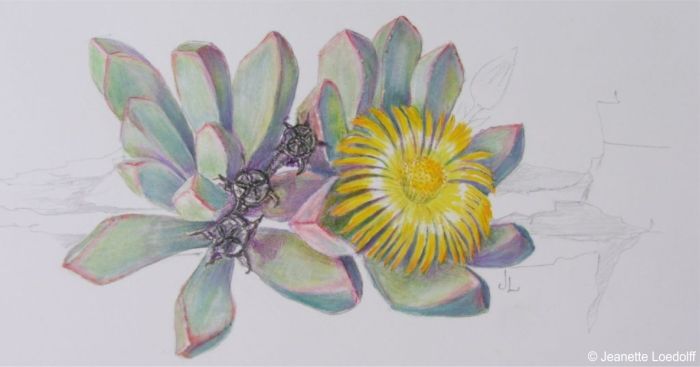
Fig. 4. An illustration of Carruanthus peersii by Jeanette Loedolff from a plant growing in the succulent collection of Kirstenbosch National Botanical Garden (ex Toorwater Poort 4 April 2002).
Derivation of name and historical aspects
History
The genus Carruanthus was established by the German botanist Gustaf Schwantes in 1927 and the name Carruanthus pertains to both, the Karoo (carru) and anthus, the Greek for ‘flower’ (Clark & Charters 2016). Carruanthus consists only of two species, C. peersii L. Bolus and C. ringens (L.) Boom. This small genus is confined to the Willowmore and Oudtshoorn districts.
Carruanthus peersii was named by the botanist Louisa Bolus in her Notes on Mesembryanthemum and allied genera in 1936. It honours V.S. Peers (1874–1940), Australian collector of plants who settled in South Africa just after the Anglo-Boer War (Gunn & Codd 1981), and who first collected this species, in August 1925.
Carruanthus peersii is related to Carruanthus ringens and can also be confused with Bijlia tugwelliae. Carruanthus peersii is immediately distinguished from C. ringens by its toothless (or almost toothless), oblong, trigonous-clavate leaves and mat-forming clusters often becoming pendent on the cliff. Carruanthus ringens is a more compact plant with shorter almost triangular leaves bearing distinct teeth. Unlike C. peersii which is confined to cliffs, C. ringens is confined to conglomerate and quartz (quartzitic sandstone) hills and flats. Bijlia tugwelliae is immediately distinguished by its sickle-shaped leaves and capsules with covering membranes. The latter grows on cliffs along the Groot Swartberg west of Prince Albert. The capsules with locules of which the covering membranes are present. In Mesembs of the World (Smith et al. 1998) the three pictures on page 181 were wrongly identified and the upper photo depicts. C. peersii and the lower two, C. ringens. Carruanthus peersii has been introduced to Kirstenbosch National Botanical Garden and Babylonstoren Farm where plants can be observed in the succulent house growing in ceramic containers.
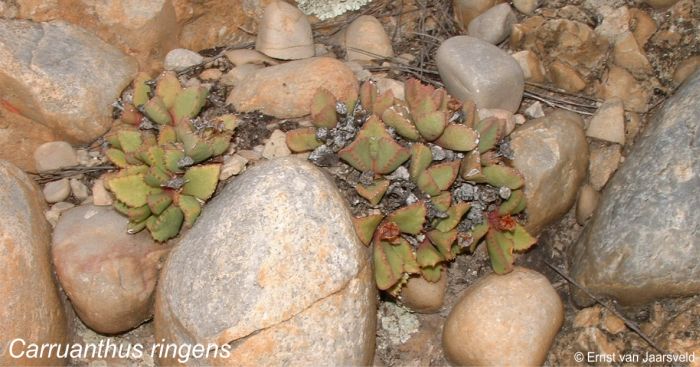
Fig. 5.Carruanthus ringens growing on Enon Conglomerate soil. It is related to Carruanthus peersii but with shorter, distinctly toothed leaves.
Ecology
Ecology
The succulent nature of the plant allows its survival during dry conditions of its habitat. If compared with Carruanthus ringens, the leaves have no teeth (rarely with ample teeth), suggesting a moisture strategy that differs from that of Carruanthus ringens. In C. ringens, the leaves have teeth, possibly functioning as a ‘dew trap’ or ‘fog trap’ on flat areas. The leaf margins in C. peersii are smooth or with only faint remnants of teeth, suggesting a different strategy and the subsequent loss of teeth. The leaves are glaucous, green to dirty green, plants becoming purplish green with the production of the betanin pigment during periods of drought, which reduces penetration of light from the sun. Plants are slow-growing, long-lived perennials.
Carruanthus peersii flowers in spring and its yellow flowers are pollinated by insects. The fruits of Carruanthus peersii, like most mesembs, arehygrochastic capsules that open with rain and seeds are dispersed by ‘wash-out dispersal’ (Hartmann 1988). These capsules have no covering membranes. Rain fills the bowl-like cavity of the capsule and all the seeds are washed or splashed out. This dispersal strategy would ensure local dispersal on the cliff, the small, oval seeds easily becoming wedged in crevices, ideal for establishment of seedlings.Seeds are released in autumn and winter, with the onset of autumn or winter rains, thus during the cool season, maximising establishment.
Plants also increase vegetatively, forming small, dense mats or clusters, with active vegetative growth and rooting where they come into contact with soil, an efficient vegetative dispersal backup and adaptation to the cliff face.
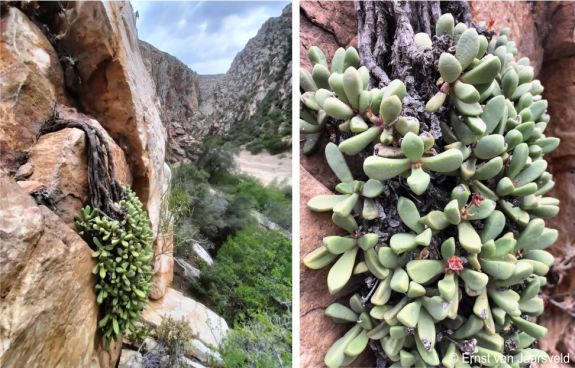
Fig. 6. A large cluster of Carruanthus peersii growing on a cliff at Toorwater Poort (January 2023).
Uses
Use
Apart from growing it as an ornamental, no other local uses have been recorded.
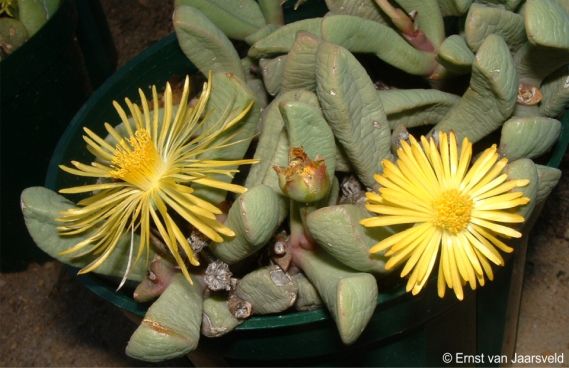
Fig. 7. Carruanthus peersii in flower growing in a container in the succulent collection of Kirstenbosch National Botanical Garden (ex Toorwater Poort, 4 April 2002).
Growing Carruanthus peersii
Grow
Carruanthus peersii is an easily grown mesemb and is best suited for thicket and succulent karoo gardens, or semi-arid savanna and Mediterranean-climate gardens. However, compared to most other mesembs, Carruanthus peersii is a slower grower, and when planted under normal garden conditions, with competition from other faster and more aggressively growing species, it would soon be overgrown and suffocated. Therefore it is best to grow it in a container on a stoep or windowsill. Carruanthus peersii is a long-lived perennial, eventually forming a branched, procumbent shrublet to 20 cm in diameter becoming pendent when grown on an embankment or in a hanging basket.
Plant it in a sunny, well-drained site, preferably in pockets created by an artificial rockery or embankment. Carruanthus peersii can also be grown in partial shade. Water well during summer and autumn and less so during winter and early spring. Adding an organic fertilizer to the watering, will enhance their growth and flowering performance. Carruanthus peersii has been grown with success in the Babylonstoren Succulent House and is not shy to flower in the spring
Propagate Carruanthus peersii from cuttings, about 3-8 cm in length. Remove the lower leaves and root in sand in spring or summer. Plants are slow growing but will eventually form clusters, flowering in spring. Water sparingly and ensure that the growing medium is well drained at all times. Sow seed in spring or summer in a shallow tray in a gravelly medium. Sow evenly on the surface and cover the seeds with a thin layer or sand 1-2 mm thick. Place in a partially shaded area and keep moist. Germination is usually within 3 weeks. The seedlings can be planted out in small individual trays once big enough to handle.
References
- Bolus, L. 1936. Notes on Mesembryanthemum and allied genera Part 3. University of Cape Town.
- Clarke, H. & Charters, M. 2016. The illustrated dictionary of southern African plant names. Flora & Fauna Publications Trust, Jacana, Johannesburg.
- Hartmann, H.E.K. 2001. Illustrated Handbook of Succulent Plants: Aizoaceae A–E. Springer, Berlin.
- Herre, H. 1971. The genera of the Mesembryanthemaceae. Tafelberg, Cape Town.
- Mucina, L. & Rutherford, M.C. (eds) 2006. The vegetation of South Africa, Lesotho and Swaziland. Strelitzia 19. South African National Biodiversity Institute, Pretoria.
- Raimondo, D., Von Staden, L., Foden, W., Victor, J.E., Helme, N.A., Turner, R.C., Kamundi, D.A. & Manyama, P.A. (eds) 2009. Red list of South African plants. Strelitzia 25. South African National Biodiversity Institute, Pretoria.
- Schwantes, G. 1927. Zur Systematik der Mesembrianthemem. ZSK 3: 105-106.
- Schwantes, G. 1957. Flowering stones and midday flowers. Benn, London.
- Smith, G.F., Chesselet, P., Van Jaarsveld, E.J., Hartmann, H., Hammer, S., Van Wyk, B-E., Burgoyne, P., Klak, C. & Kurzweil, H. 1998. Mesembs of the world. Briza, Pretoria.
- Van Jaarsveld, E.J. 2010. Waterwise gardening in South Africa and Namibia. Struik, Cape Town.
- Van Wyk, A.E. & Smith, G.F. 2001. Regions of floristic endemism in South Africa. A review with emphasis on succulents. Umdaus Press, Hatfield, Pretoria
Credits
Ernst van Jaarsveld
Kirstenbosch National Botanical Garden (Retired 2015)
Babylonstoren Farm
Extraordinary senior lecturer and researcher,
Department of Biodiversity and Conservation, University of the Western Cape
August 2023
Plant Attributes:
Plant Type: Succulent
SA Distribution: Eastern Cape, Western Cape
Soil type: Sandy, Loam
Flowering season: Spring, Sporadic/All year
PH: Acid
Flower colour: Yellow
Aspect: Full Sun, Morning Sun (Semi Shade), Afternoon Sun (Semi Shade)
Gardening skill: Easy
Special Features:
Horticultural zones








Rate this article
Article well written and informative
Rate this plant
Is this an interesting plant?
Login to add your Comment
Back to topNot registered yet? Click here to register.